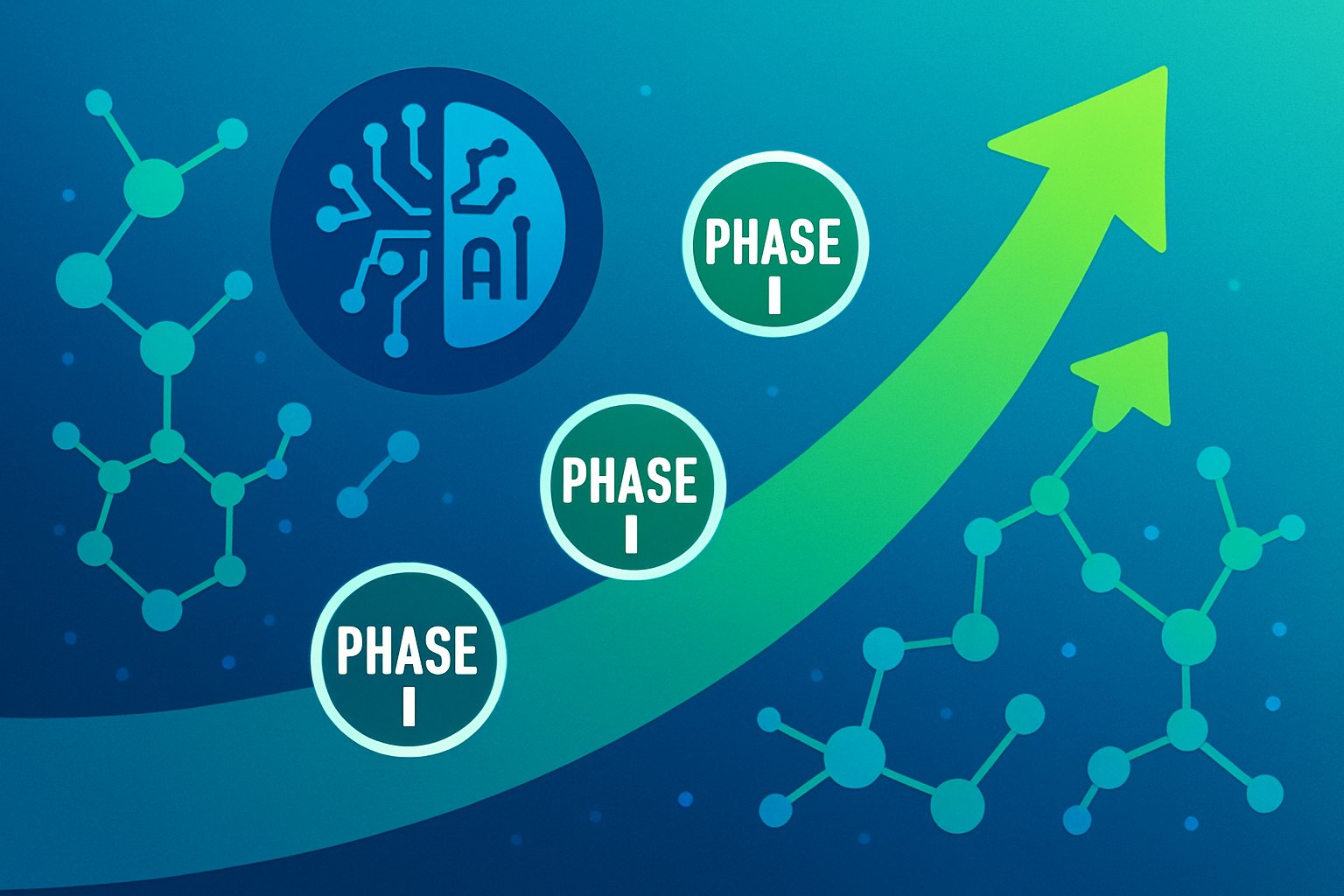
AI CERTS
17 hours ago
AI-Accelerated Pharmacology Drives 90% Phase I Wins
Boston Consulting Group authors stress the finding is a first look, not a final verdict. Nevertheless, the analysis hints that algorithmic screening, toxicity flagging, and in silico ADMET prediction can slash early safety failures. In turn, the promise of fewer costly dead ends is reigniting discussions about efficient capital deployment. Therefore, many R&D leaders now treat AI-Accelerated Pharmacology as a credible productivity lever rather than distant hype.

Phase I Safety Surge
The core statistic is stark. Additionally, 80–90 percent of AI-origin molecules survived initial human testing. In contrast, historical transition studies, including Hay et al. and IQVIA, rarely exceed 50 percent. Furthermore, the BCG dataset covers 75 AI-generated candidates that have reached the clinic since 2015, showing pipeline breadth, not just isolated wins.
Why does safety improve? Algorithms sift vast compound libraries, eliminate reactive groups, and optimize pharmacokinetics before synthesis. Consequently, many liabilities never reach animal studies, let alone volunteers. This workflow embodies AI-Accelerated Pharmacology in action. Meanwhile, molecule prediction systems continue refining property scores with fresh omics data, further reducing surprises.
These gains matter for budgets. Fewer Phase I failures mean lower write-offs and steadier program cadence. However, early safety does not guarantee efficacy. The next section contrasts current optimism with broader benchmarks.
Benchmarking Industry Success Rates
IQVIA’s 2024 report placed overall Phase I success at 48 percent. Moreover, oncology programs sat even lower. Therefore, the 80–90 percent figure for AI-native firms appears extraordinary. Nevertheless, analysts caution against direct comparisons because therapeutic mixes differ.
The BCG paper focused on AI-first startups, many of which choose validated targets to showcase platform speed. Consequently, risk profiles skew toward safer bets. In contrast, big pharma portfolios contain higher-risk biology. Additionally, reporting lag can inflate apparent wins; negative readouts sometimes surface months later. Such caveats temper enthusiasm while preserving intrigue around AI-Accelerated Pharmacology.
Still, relative improvements cannot be ignored. Even after adjustments, BCG modeling suggests end-to-end approval odds could double if early gains persist. However, the industry must see Phase II data before celebrating a revolution.
Mechanisms Behind Early Gains
Multiple technical levers explain the safety surge. Firstly, clinical trial AI platforms mine real-world toxicity reports to exclude risky scaffolds. Secondly, generative chemistry engines propose structures with built-in ADMET constraints. Additionally, structure-prediction networks akin to AlphaFold estimate off-target binding early.
Consequently, benches focus on candidates already primed for human exposure. Moreover, molecule prediction systems iterate thousands of virtual analogs overnight, seeking optimal polarity and metabolic stability. Therefore, physical synthesis follows only when digital scores surpass stringent cutoffs.
This closed-loop design-make-test cycle embodies AI-Accelerated Pharmacology. Importantly, safety pharmacologists now collaborate with data scientists daily, shrinking traditional handoff gaps. Such integration underpins the reported Phase I uplift, yet efficacy biology remains the larger obstacle.
Caveats Temper Early Enthusiasm
Several limitations cloud the rosy picture. However, small sample size tops the list. Twenty-four completed trials cannot anchor long-term forecasts. Furthermore, most candidates emerged from well-funded startups eager to publicize successes, raising survivorship bias concerns.
In contrast, unpublished failures inside large pharma AI programs may never reach journals, skewing public datasets. Additionally, Phase II numbers already look average: 40 percent success for the 10 AI molecules that advanced. Therefore, efficacy translation is far from solved by algorithms alone.
Regulators could also challenge black-box models used during candidate selection. Consequently, documentation standards may tighten, potentially slowing future filings. These realities remind stakeholders that AI-Accelerated Pharmacology provides tools, not miracles.
Company Case Study Highlights
Real-world stories illustrate promise and peril. Exscientia celebrated a rapid IND approval for EXS74539 in 2023. Nevertheless, the company shelved another asset, EXS21546, after equivocal tumor responses. Meanwhile, Recursion advanced several neurologic candidates swiftly but discontinued REC-994 following mixed Phase II signals.
Such pivots reveal that strong Phase I tolerability does not immunize programs against biological complexity. Additionally, clinical trial AI dashboards helped both firms reprioritize assets swiftly, limiting sunk costs. Moreover, partnerships with larger pharmas bring fresh capital yet impose rigorous go-/no-go gates.
Professionals can strengthen decision skills through the AI + Doctor certification, which covers algorithmic validation and regulatory expectations. Consequently, teams gain shared language when assessing AI-derived safety signals.
Implications For Drug Developers
Strategic planners see three major impacts:
- Higher Phase I success lowers blended portfolio risk.
- Shorter preclinical cycles free scarce chemistry resources.
- Data-rich assets attract earlier licensing interest.
Furthermore, rising expectations will pressure legacy workflows to modernize. Therefore, firms lacking robust molecule prediction systems might struggle to recruit data-savvy talent. In contrast, early adopters already embed clinical trial AI tools within electronic lab notebooks, capturing continuous feedback.
Nevertheless, leadership must temper boardroom excitement with realistic probability models. End-to-end approval still hinges on disease biology, trial design, and reimbursement climates. Hence, AI-Accelerated Pharmacology should complement, not replace, classical translational science.
Next Steps For Validation
Independent replication remains the gold standard. Consequently, journalists and investors should request the BCG supplementary tables that list all 24 Phase I programs. Additionally, cross-checking ClinicalTrials.gov entries will expose any silent reversals.
Future analyses must also incorporate big-pharma internal programs, where data access is harder. Moreover, upcoming Phase II readouts through 2025 will reveal whether early safety edges evolve into efficacy gains. Therefore, watch lists should include Insilico Medicine, Atomwise, and Generate Biomedicines, all nearing crucial inflection points.
Meanwhile, professionals upgrading their skill sets through the AI + Doctor course will be positioned to interpret emerging datasets critically. Consequently, organizations can pivot quickly as new evidence refines the outlook for AI-Accelerated Pharmacology.
The preliminary data suggest a tangible safety advantage. However, statistical power will rise only with more trials and transparent reporting. These validation steps will determine whether the current 80–90 percent figure becomes an enduring benchmark or a transient anomaly.



